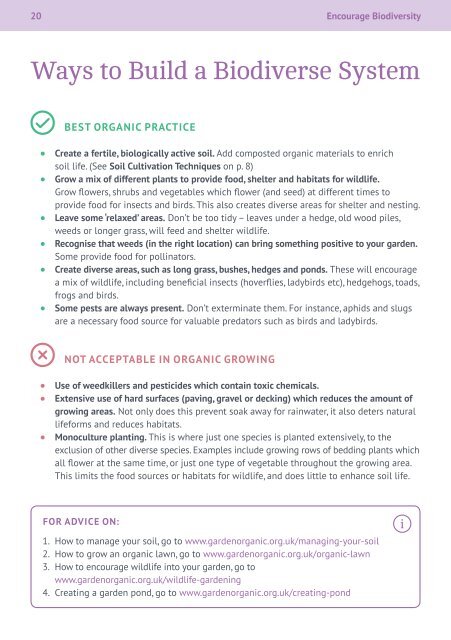Garden Organic Booklet - Final Draft 01
Create successful ePaper yourself
Turn your PDF publications into a flip-book with our unique Google optimized e-Paper software.
20 Encourage Biodiversity<br />
Encourage Biodiversity<br />
Ways to Build a Biodiverse System<br />
Encouraging Wildlife<br />
BEST ORGANIC PRACTICE<br />
• Create a fertile, biologically active soil. Add composted organic materials to enrich<br />
soil life. (See Soil Cultivation Techniques on p. 8)<br />
• Grow a mix of different plants to provide food, shelter and habitats for wildlife.<br />
Grow flowers, shrubs and vegetables which flower (and seed) at different times to<br />
provide food for insects and birds. This also creates diverse areas for shelter and nesting.<br />
• Leave some ‘relaxed’ areas. Don’t be too tidy – leaves under a hedge, old wood piles,<br />
weeds or longer grass, will feed and shelter wildlife.<br />
• Recognise that weeds (in the right location) can bring something positive to your garden.<br />
Some provide food for pollinators.<br />
• Create diverse areas, such as long grass, bushes, hedges and ponds. These will encourage<br />
a mix of wildlife, including beneficial insects (hoverflies, ladybirds etc), hedgehogs, toads,<br />
frogs and birds.<br />
• Some pests are always present. Don’t exterminate them. For instance, aphids and slugs<br />
are a necessary food source for valuable predators such as birds and ladybirds.<br />
NOT ACCEPTABLE IN ORGANIC GROWING<br />
• Use of weedkillers and pesticides which contain toxic chemicals.<br />
• Extensive use of hard surfaces (paving, gravel or decking) which reduces the amount of<br />
growing areas. Not only does this prevent soak away for rainwater, it also deters natural<br />
lifeforms and reduces habitats.<br />
• Monoculture planting. This is where just one species is planted extensively, to the<br />
exclusion of other diverse species. Examples include growing rows of bedding plants which<br />
all flower at the same time, or just one type of vegetable throughout the growing area.<br />
This limits the food sources or habitats for wildlife, and does little to enhance soil life.<br />
Birds, insects, small mammals and amphibians not only add to the biodiversity of your<br />
growing patch, but also many of them act as predators on pests such as slugs, snails and aphids.<br />
As a result, there is no need for toxic chemicals. Whether you grow in pots in a backyard,<br />
a window box or an allotment, it’s exciting to know that you can encourage all sorts of wildlife –<br />
from a moth to a bat, a robin or a bumble bee.<br />
BEST ORGANIC PRACTICE<br />
• Grow a mix of different plants to provide food, shelter and habitats for wildlife.<br />
Flowers, shrubs and vegetables should all be grown, to provide food for insects and birds.<br />
This also creates diverse areas for shelter and nesting.<br />
• Grow a variety of flowers, which bloom and seed at different times. Flowers support<br />
insect and bird life. They can provide nectar for butterflies and bees; leaves for<br />
caterpillars and beetles; stems for insects to hibernate in; night scent to attract moths;<br />
as well as seed heads as a source of food for birds during winter.<br />
• Grow trees and shrubs. If you have the space, plant trees and shrubs. They provide a<br />
rich larder of leaves and fruits, shade and shelter, as well as perching and nesting areas.<br />
• Look after the birds. Provide suitable habitat for them to nest and perch. Feed them in<br />
the winter, and make sure they have access to water. Check RSPB guidelines.<br />
• Create a garden pond. This creates a suitable habitat for amphibians such as frogs,<br />
toads and newts to breed, and provides water for birds.<br />
• Create nesting areas for insects. You can create sheltered conditions for aphid-eating<br />
ladybirds and pollinators such as bees and hoverflies to overwinter.<br />
FOR ADVICE ON:<br />
1. How to manage your soil, go to www.gardenorganic.org.uk/managing-your-soil<br />
2. How to grow an organic lawn, go to www.gardenorganic.org.uk/organic-lawn<br />
3. How to encourage wildlife into your garden, go to<br />
www.gardenorganic.org.uk/wildlife-gardening<br />
4. Creating a garden pond, go to www.gardenorganic.org.uk/creating-pond<br />
21



